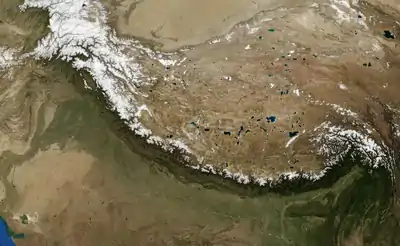Main Frontal Thrust
The Main Frontal Thrust (MFT), also known as the Himalayan Frontal Thrust (HFT), is a geological fault in the Himalayas that defines the boundary between the Himalayan foothills and Indo-Gangetic Plain.[1] The fault is well expressed on the surface thus could be seen via satellite imagery. It is the youngest and southernmost thrust structure in the Himalaya deformation front. It is a splay branch of the Main Himalayan Thrust (MHT) as the root décollement.
| Main Frontal Thrust | |
|---|---|
| Himalayan Frontal Thrust | |
 | |
| Country | Nepal, India, Pakistan, Bhutan |
| Characteristics | |
| Range | Himalayas |
| Length | 2,400 km |
| Displacement | 15-21 mm/yr |
| Tectonics | |
| Status | Active |
| Type | Thrust |

It runs parallel to other major splays of the MHT; Main Boundary Thrust (MBT) and Main Central Thrust (MCT). The Sunda Megathrust, which extends from the Banda Islands to Myanmar is joined with the MFT.[2] The fault strikes in a NW-SE direction and dips at an angle of 20° to 30° in the north.[3]
Main Boundary Thrust
The Main Boundary Thrust (MBT) is another major thrust fault in the Himalaya orogenic wedge that was active in the Cenozoic.[4] It runs parallel to the MFT with a spacing distance of about 20 km.
Shortening rate
Shortening rate varies across the MFT, these figures provide the speed in various locations.[2]
| Region | Rate (mm/yr) | |
|---|---|---|
| Pakistan | 14 ± 4 | minor components within the Himalayas also accounts for shortening |
| Northwestern India | 10-14 | |
| Nepal | 21 ± 1.5 | |
| Bhutan | 15-20 |
Seismic activity
The MFT accommodates almost the entire rate of subduction of the Indian Plate therefore, it is no surprise that numerous earthquakes have occurred along this fault, and is expected to produce very big earthquakes in the future.[5] Many earthquakes associated with the MFT has resulted in visible ground ruptures, as seen in the Bihar earthquake of 1934 and 1505 magnitude 8.2-8.8 earthquake.
References
- Paul, R.; Bhakuni, S.S. "Structural analysis of main boundary thrust and Himalayan frontal thrust around Dehra Dun, NW Himalaya: Implications of neotectonics". Summer Research Fellowship Programme of India's Science Academies. Retrieved 21 October 2020.
- Burgess, W.P.; Yin, A.; Dubey, C.S.; Shen, Z–K.; Kelty, T.K. (2012). "Holocene shortening across the Main Frontal Thrust zone in the eastern Himalaya". Earth and Planetary Science Letters. 357–358: 152–167. doi:10.1016/j.epsl.2012.09.040.
- Wesnousky, S.G.; Kumar, S.; Mohindra, R.; Thakur, V.C. (1999). "Uplift and convergence along the Himalayan Frontal Thrust of India". Tectonics. 18 (6): 967–976. doi:10.1029/1999TC900026. S2CID 128412302.
- Mugnier, J–L.; Huyghe, P.; Chalaron, E.; Mascle, G. (1994). "Recent movements along the Main Boundary Thrust of the Himalayas: Normal faulting in an over-critical thrust wedge?". Tectonophysics. 238 (1–4): 199–215. doi:10.1016/0040-1951(94)90056-6.
- Bilham, R. (2019). "Himalayan earthquakes: a review of historical seismicity and early 21st century slip potential". In Treloar, P.J.; Searle, M.P. (eds.). Himalayan Tectonics: A Modern Synthesis. Geological Society, London, Special Publications. Vol. 483. pp. 423–482. doi:10.1144/SP483.16. ISBN 9781786204059. S2CID 133821585.